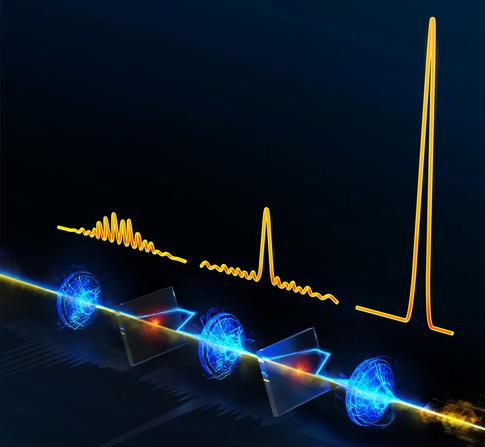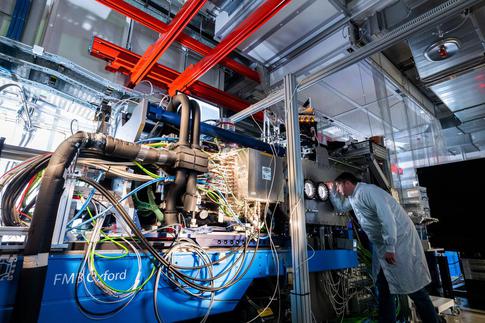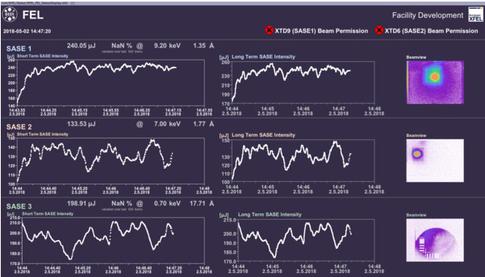您当前的位置: 首页 > 学校概况

学校简介:
学校教员: 人,学生数量:人, 校友数量: 人,子机构数量:个, 相关机构: 个,受资助项目:项, 文章数: 篇,专利数:项,

An international team of scientists at European XFEL and DESY has demonstrated adevice to significantly increase the amount of X-rays with sharply defined wavelengths generated by an X-ray laser at high repetition rates.The novel cascaded setup opens up new experimental possibilities in awide range of scientific fields employing ultrafast X-ray spectroscopy,scattering and imaging techniques.To explore the physical and material properties of samples on the time scale of femtoseconds,scientists need light sources that provide X-rays flashes at very high repetition rate,with short pulse durations and aspectral flux—i.e.the rate at which X-ray photons of agiven wavelength are emitted by the source—significantly larger than what has been available at X-ray laser sources around the world so far.Using asophisticated,cascaded Hard X-Ray Self-Seeding(HXRSS)setup,a team led by European XFEL succeeded in generating very bright X-ray flashes at the high repetition rates of the European XFEL accelerator.In aconventional HXRSS setup,electron bunches from alinear accelerator generate X-ray radiation in afirst magnetic arrangement—the first undulator section—according to the self-amplified spontaneous emission(SASE)scheme.A special filtering process selects only anarrow wavelength range of the radiation,which is then fed as a“seed”into asecond undulator section,where it is amplified again.However,due to the high(megahertz)repetition rate of the European XFEL,the diamond crystal that constitutes the main part of the filtering setup heats up,resulting in ashift and adeformation of the range of selected wavelengths.This unwanted effect was now studied for the first time and demonstrated to be important at X-ray wavelengths longer than 1.5 angstrom.In order to avoid it,an international team of scientists at the European XFEL realized acascaded setup,where the filtering process is repeated with asecond crystal and afinal undulator section.In the end,the setup generated thousands of X-ray pulses per second with very narrow spectral bandwidth—i.e.sharply defined wavelength—and an average spectral brightness that was about two orders of magnitude higher compared to any other such X-ray laser facility worldwide.“We are very happy that hard X-ray self-seeding has now also become reality at European XFEL,more than 10 years after its first theoretical description by ateam of DESY FEL physicists,”says Winfried Decking,coordinator of the European XFEL accelerator at DESY.“The present schemes can make optimal use of the high repetition rate provided by the superconducting linear accelerator.” 查看详细>>
来源:EuropeanXFEL 点击量: 4
A new spectrometer at the European XFEL’s small quantum systems(SQS)instrument will measure soft x-ray radiation and extreme ultraviolet(XUV)light generated by gaseous samples after interaction with intense XFEL pulses.This enables fresh avenues of research for the instrument.The spectrometer was built by acollaboration involving scientists from European XFEL and Uppsala University in Sweden,and will allow scientists at SQS to probe new and exciting processes on the atomic scale.“The spectrometer will give us the ability to look at XUV light emitted from atoms and molecules.Its unique capability to image along the interaction zone enables us to study the effect of European XFEL’s intense X-ray radiation as it travels through dense gases,”says Michael Meyer,leading scientist of the SQS instrument.“It will offer new possibilities to study fundamental processes in the interaction of x-ray radiation with matter.”Radiation with wavelengths in the extreme ultraviolet(XUV)range is emitted upon excitation or ionization of asample by the European XFEL pulses.Spectroscopy of these emitted XUV photons is an ideal tool for studying the quantum mechanical properties of the sample in its interaction with the intense X-ray pulses.This is particularly useful in comparison with other techniques based on electron or ion spectroscopy as the photons are not severely impacted by the charged particles created during the interaction.“At SQS we study fundamental properties of atomic and molecular systems,predominantly looking at electrons and ions.The new spectrometer complements these techniques and helps us to better understand physics on the very small scale,”says Thomas Baumann,scientist at SQS. 查看详细>>
来源:EuropeanXFEL 点击量: 8
Developing our understanding of biological processes can lead to better treatments for disease.Now,an international team involving the European X-ray Free Electron Laser(European XFEL)has developed anew method for tracking the reactions of proteins.The method,multi-hit serial femtosecond crystallography(SFX),developed by La Trobe University researchers,could probe biological proteins in adifferent way,providing scientists with fresh insights into their behaviour.An international team of over 50 researchers used the European XFEL to demonstrate multi-hit SFX.The European XFEL flashes on and off up to 27000 times asecond meaning that asingle biological sample can be hit by the X-ray beam twice in less than amicrosecond.The first‘hit’occurs in the‘tail’or weak edge of the beam,meaning that the sample remains intact for the second hit rather than being destroyed by the ultra-intense XFEL radiation.This allows scientists to monitor the reactions of proteins as they move,on sub-microsecond time scales.Multi-hit SFX is particularly useful for studying molecules undergoing irreversible processes,which cannot be measured using synchrotrons or lab-based X-ray sources.“Multi-hit SFX potentially opens anovel and unique window into understanding molecular processes,perhaps also for the study of therapeutics,”says Dr Adrian Mancuso,Leading Scientist at the SPB/SFX instrument at European XFEL.“This result highlights the unique advantages of the European XFEL’s pulse structure,as well as the success of this collaboration.” 查看详细>>
来源:EuropeanXFEL 点击量: 0
An international research team has used the SQS instrument at the European XFEL to gain new insights into how radiation damage occurs in biological tissue.The study reveals in detail how water molecules are broken apart by high-energy radiation,creating potentially hazardous electrically charged ions,which can go on to trigger harmful reactions in the organism.The team led by Maria Novella Piancastelli and Renaud Guillemin from the Sorbonne in Paris,Ludger Inhester from DESY and Till Jahnke from European XFEL presents its observations and analyses in the scientific journal Physical Review X.Since water is present in every known organism,the so-called photolysis of water is often the starting point for radiation damage.“However,the chain of reactions that can be triggered in the body by high-energy radiation is still not fully understood,”explains Inhester.“For example,even just observing the formation of individual ions and radicals in water when high-energy radiation is absorbed is already very difficult.”To study this sequence of events,the researchers bombarded single water molecules with pulses from the X-ray laser.These pulses are so intense,that in many cases not only one,but two or more X-ray photons were absorbed.The absorption of the second photon gave the research team aglimpse into what happens inside the molecule after the absorption of X-ray light.“The movement of the atoms of the molecule occurring between the two absorption events leaves aclear fingerprint in the fragmentation pattern of the molecule,in other words,the fragments of the molecule fly apart in avery specific,characteristic way,”says Piancastelli.“By carefully analysing this fingerprint,as well as using detailed simulations,we were able to draw conclusions about the ultra-fast dynamics of the water molecule after it had absorbed the first X-ray photon.”This allowed the scientists to record the disintegration of the water molecule,which lasted only afew femtoseconds(quadrillionths of asecond),in the form of afilm.The study shows that the disintegration of the water molecule can be much more complicated than initially expected.The water molecule(H2O)starts to stretch and expand before eventually breaking apart.After only ten femtoseconds,the two hydrogen atoms(H),which are normally attached to the oxygen atom(O)at an angle of 104 degrees,can build up so much momentum as to face each other at an angle of around 180 degrees.As aresult,the oxygen atom is not in fact flung away hard when the molecule breaks up,because the momenta of the two hydrogen nuclei largely balance each other out as they fly off,leaving the oxygen virtually at rest in the middle.In an aqueous environment,this can then easily lead to further potentially harmful chemical reactions.“In our research,we succeeded for the first time in taking acloser look at the dynamics of awater molecule after it absorbs high-energy radiation,”says Inhester,who works at the Centre for Free-Electron Laser Science(CFEL),a collaboration between DESY,the University of Hamburg and the Max Planck Society.“In particular,we were able to characterise the formation of the oxygen and hydrogen ions and radicals more precisely,as well as the way this process unfolds over time.This disintegration of the water molecule is an important first step in the further chain of reactions that ultimately lead to radiation damage.” 查看详细>>
来源:EuropeanXFEL 点击量: 0
European XFEL starts operation of its third light source,exactly ayear after the first X-ray light was generated in the European XFEL tunnels.The third light source will provide light for the MID(Materials Imaging and Dynamics)and HED(High Energy Density Science)instruments scheduled to start user operation in 2019.All three light sources,successfully run in parallel for the first time on the anniversary of European XFEL’s first light,will eventually provide X-rays for at least six instruments.At any one time,three of these six instruments can simultaneously receive X-ray beam for experiments.“The operation of the third light source,and the generation of light from all sources in parallel,are important steps towards our goal of achieving user operation on all six instruments”said European XFEL Managing Director Robert Feidenhans’l.“I congratulate and thank all those involved in this significant accomplishment.It was atremendous achievement to get all three light sources to generate light within the space of one year.”To generate flashes of X-ray light,electrons are first accelerated to near the speed of light before they are moved through long rows of magnets called undulators.The alternating magnetic fields of these magnets force the electrons on aslalom course,causing the electrons to emit light at each turn.Over the length of the undulator,the produced light interacts back on the electron bunch,thereby producing aparticularly intense light.This light accumulates into intensive X-ray flashes.This process is known as‘self-amplified spontaneous emission’,or SASE.European XFEL has three SASE light sources.The first one,SASE 1,taken into operation at the beginning of May 2017,provides intense X-ray light to the instruments SPB/SFX(Single Particles,Clusters and Biomolecules and Serial Femtosecond Crystallography)and FXE(Femtosecond X-ray Experiments),the first instruments available for experiments and operational since September 2017.The second light source,SASE 3,was successfully taken into operation in February 2018 and will provide light for the instruments SQS(Small Quantum Systems)and SCS(Spectroscopy and Coherent Scattering),scheduled to start user operation in November 2018.SASE 1and SASE 3can be run simultaneously–high speed electrons first generate X-ray light in SASE 1,before being used asecond time to produce X-ray light of alonger wavelength in SASE 3.Now,exactly ayear after the first laser light was generated in the European XFEL tunnels,the third light source,SASE 2,is operational.SASE 2will generate X-ray light for the MID(Materials Imaging and Dynamics)and HED(High Energy Density Science)instruments scheduled to start user operation in 2019.The MID instrument will be used to,for example,understand how glass forms on an atomic level,and for the study of cells and viruses with arange of imaging techniques.The HED instrument will enable the investigation of matter under extreme conditions such as that inside exoplanets,and to investigate how solids react in high magnetic fields. 查看详细>>
来源:EuropeanXFEL 点击量: 1
On Saturday,under sunny spring skies,more than 2500 visitors attended European XFEL’s first Open Day on the campus in Schenefeld.Guests of all ages enjoyed adiverse and varied program of activities,talks,exhibitions and tours,giving an insight into the work,staff and community of the new research centre.Schleswig Holsteins Minister for Science Karin Prien,Schenefeld Mayor Christiane Küchenhof and European XFEL Managing Director Prof.Robert Feidenhans’l officially opened the event just after midday.“It’s great to see so much interest in our facility!”said Feidenhans’l.“We are very proud to be able to present our facility.More than 150 staff members of European XFEL,as well as our campus partners have worked really hard in preparation for this premiere.Seeing so much enthusiasm for science among people of all age groups is an additional boost for our work during the next few weeks and months.I thank all staff member and campus partners for their support that has made this day possible.”Later Hamburg’s second mayor and science minister Katharina Fegebank also visited the event and greeting the visitors.On the main stage Insa Backe moderated adiverse program of inspiring talks from European XFEL and DESY staff,soothing music,and exploding science shows from"Magic Andy".Away from the action and music,the Naturschutzbund Deutschland(NABU)offered visitors achance to sit back with acup of coffee in the spring sunshine while making seed bombs,enjoying the natural beauty of the campus and chat about the renaturation activities on site.Other collaboration partners included DESY,who set up acontrol room for the event enabling visitors to watch the European XFEL accelerators in action.The DESY technical services truck was also on show on site as was the local fire brigade who offered water shooting games. 查看详细>>
来源:EuropeanXFEL 点击量: 5
The second X-ray light source has successfully been taken into operation at European XFEL,the world’s largest X-ray laser located in the Hamburg metropolitan region.The X-ray light source SASE3 successfully produced X-ray laser light flashes in one of the underground tunnels.SASE3 will serve two experiment stations scheduled to begin user operation at the end of the year.Since the start of operation in September 2017,340 scientists from across the globe have already used the facility for their research.The successful start of operation of the new SASE 3source will enable the facility to increase the number of users further.European XFEL Managing Director Prof.Robert Feidenhans’l said:“The construction and commissioning of the new light source are complex processes,for which we and our DESY colleagues have been preparing intensely for these last weeks and months.We are very happy that the commissioning of this second light source SASE 3has also run so smoothly,and that both sources,SASE1 and SASE3,produce light simultaneously.For this Iwould like to thank all those involved,in particular the accelerator team from DESY.We continue to be on schedule to start operation at all four experiment stations currently under construction,beginning with the first two instruments in November.The remaining two will start operation at the beginning of 2019.This will increase our current capacity threefold by mid 2019.”The new X-ray light source SASE3 uses electrons that have first passed through the light source SASE1 where they have already produced laser light.SASE3 provides laser light that will provide X-ray light for the experiment stations SQS and SCS,which are currently under construction.The SQS instrument(Small Quantum Systems)is specialized for the study of fundamental processes such as how chemical bonds break in molecules,or what happens on the atomic level when materials absorb many photons at the same time.The SCS instrument(Spectroscopy and Coherent Scattering)will focus on the investigation of fast changes in material properties,such as within magnetic materials,materials that withstand extreme temperatures,superconducting materials,and also biological samples.The research at these two stations has relevance for basic research but also for the development of new materials in the fields of IT,medicine,energy research,and catalysts,among others.Dr.Winni Decking,responsible for the operation of the European XFEL accelerator at DESY,explained:“The first X-ray laser light at SASE3 is aspecial moment for the technicians,engineers,and scientists who,over many years,have contributed to the construction of the facility with great care and precision.The fact that we have achieved this milestone so soon after the first round of user operation also shows how well the operation teams from DESY and European XFEL work together.”The European XFEL X-ray laser light is extremely intense and million times brighter than current synchrotron light sources.With the European XFEL,up to 27 000 light flashes per second can be produced,making the facility unique worldwide.In order to accomplish this,the superconducting accelerator technology developed at DESY is used at European XFEL.The X-ray light flashes are produced in the tunnels from bunches of electrons that have been accelerated to nearly the speed of light and have alot of energy.These bunches are repeated regularly at extremely short time intervals.Up to 200m long magnetic structures,so-called undulator systems,send the accelerated electrons on atight slalom course.At every turn,the electron bunches send out X-ray light pulses that build on one another. 查看详细>>
来源:EuropeanXFEL 点击量: 21